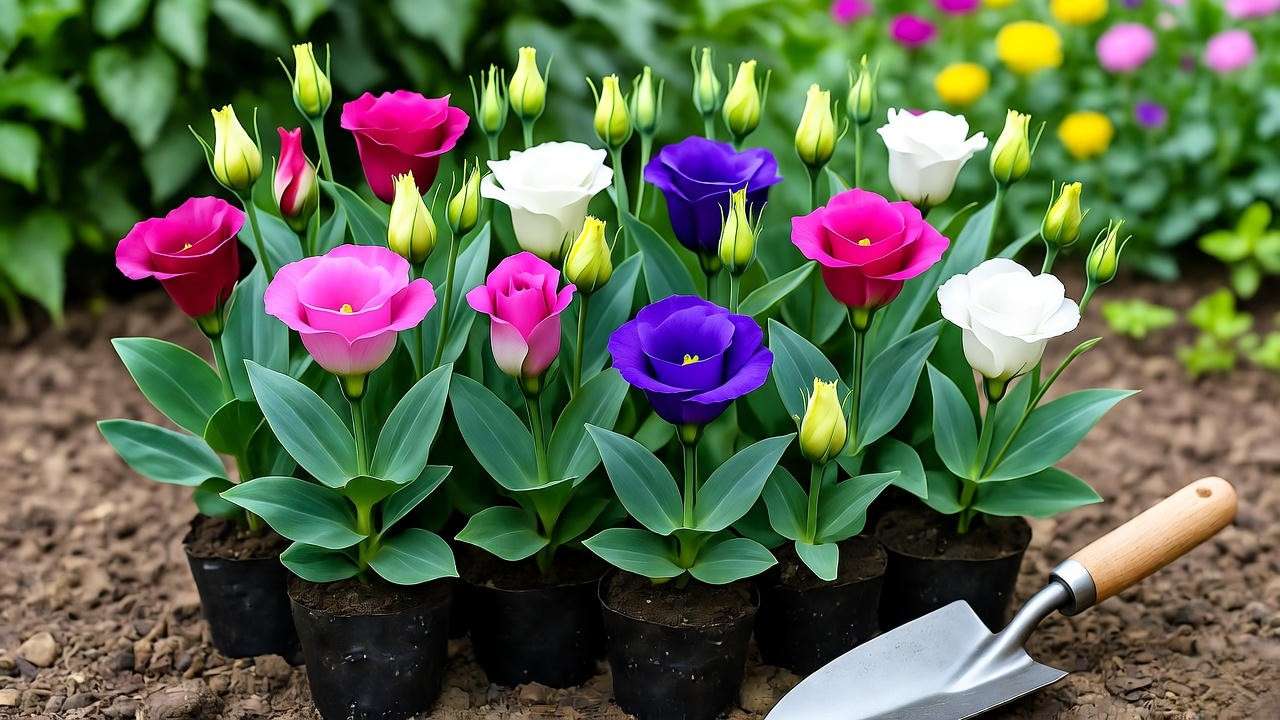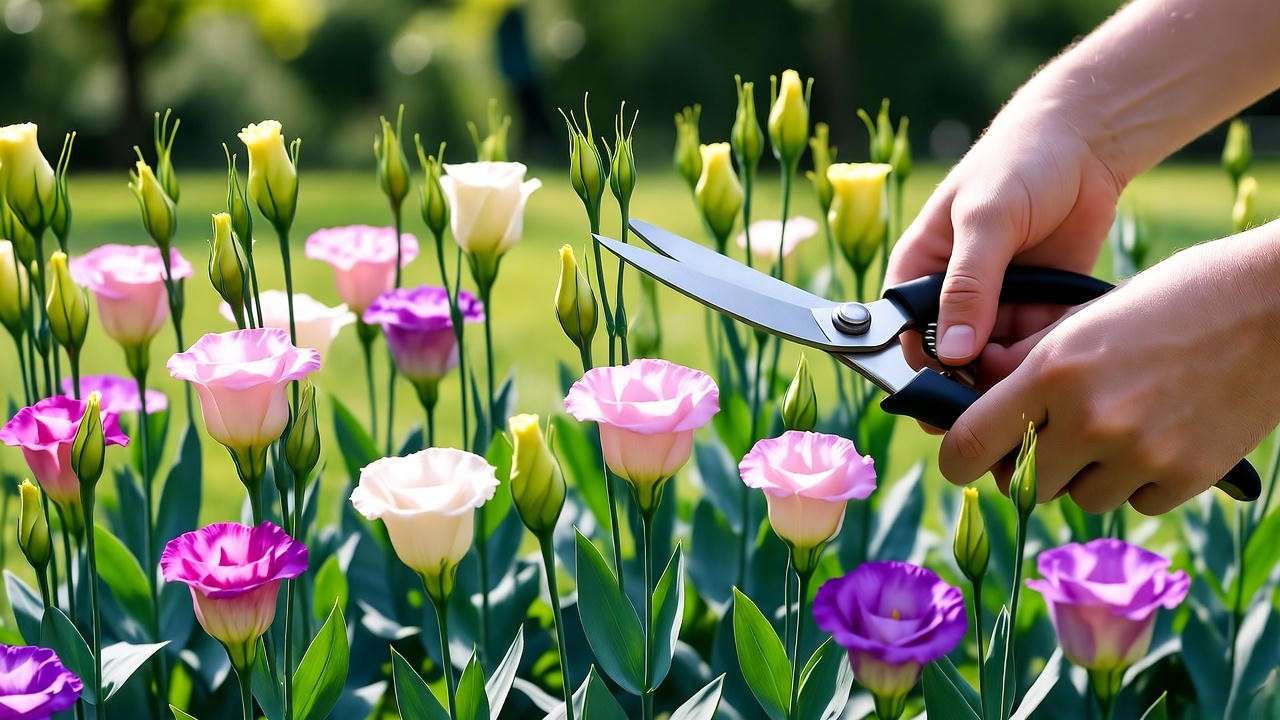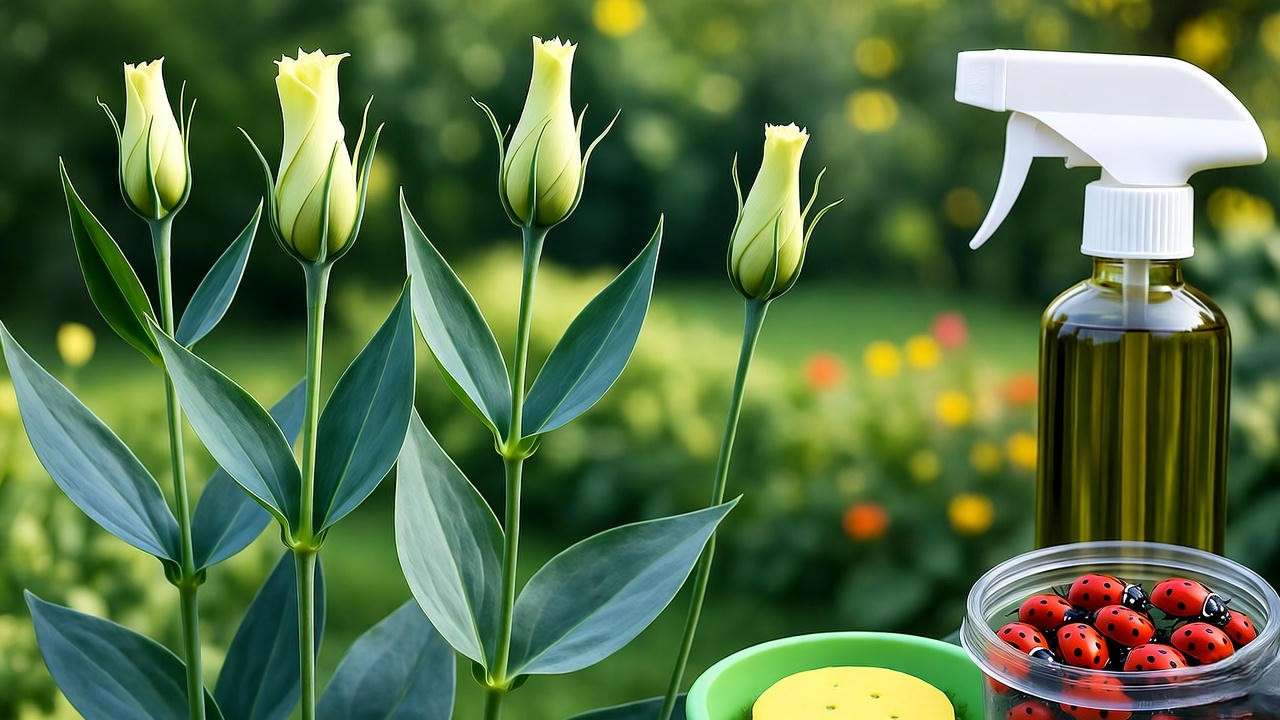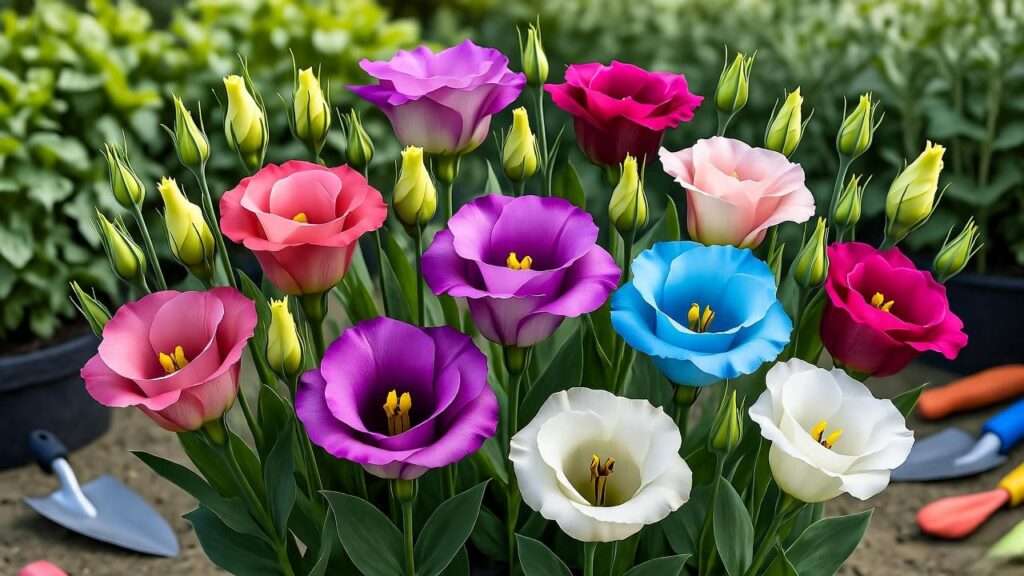Imagine transforming your garden into a vibrant tapestry of rose-like blooms that rival the elegance of peonies, all from the humble beginnings of lisianthus plug plants! These delicate yet resilient flowers, known as prairie gentians, are a gardener’s dream for their stunning colors, long vase life, and versatility in both gardens and floral arrangements. Whether you’re a novice or a seasoned horticulturist, this comprehensive guide will equip you with expert strategies to grow lisianthus plug plants successfully. With over a decade of experience cultivating these beauties across various climates, I’ll share practical tips to overcome common challenges and ensure your lisianthus thrives. Let’s dive into the art and science of growing these floral gems! 🌼
1. Understanding Lisianthus Plug Plants: The Basics 🌼
1.1 What Are Lisianthus Plug Plants?
Lisianthus plug plants are young, pre-grown seedlings sold in small containers or trays, ready for transplanting into your garden or pots. Unlike starting from seeds, which can be slow and finicky, plugs offer a head start, making them ideal for gardeners seeking faster results. Native to North America, lisianthus (Eustoma grandiflorum) boasts elegant, rose-like blooms in shades of white, pink, purple, and blue. These plants are prized for their durability as cut flowers and their ability to add sophistication to any garden bed or bouquet. 🌷
1.2 Why Choose Lisianthus for Your Garden?
Lisianthus is a standout choice for its aesthetic appeal and versatility. Its blooms, often mistaken for roses, bring a touch of elegance to borders, containers, or mixed flower beds. With a blooming season stretching from summer to early fall, lisianthus delivers months of color when cared for properly. Florists adore it for its long vase life (up to two weeks), while home gardeners appreciate its adaptability to various growing conditions. Whether you’re designing a cottage garden or crafting wedding bouquets, lisianthus is a must-have. 🌺
Expert Insight: In my years growing lisianthus in a Zone 6 garden, I’ve found plugs to be a game-changer. One season, despite a late frost, my plug-planted lisianthus bloomed vibrantly by mid-summer, proving their resilience and ease for beginners.
2. Preparing to Grow Lisianthus Plug Plants: Setting the Stage 🌞
2.1 Choosing the Right Lisianthus Plug Plants
Selecting high-quality lisianthus plug plants is the first step to success. Popular varieties include the Echo series (known for double blooms), Arena (compact and vibrant), and Mariachi (ideal for cut flowers). Purchase from reputable nurseries like Johnny’s Selected Seeds or local garden centers to ensure healthy stock. Look for compact plugs with dark green leaves, no yellowing, and no signs of pests or disease. A healthy plug should have a robust root system visible through the tray’s drainage holes. 🌱
2.2 Understanding Ideal Growing Conditions
Lisianthus thrives in specific conditions. They prefer USDA zones 8–10 as perennials but can be grown as annuals elsewhere. Full sun (6–8 hours daily) is non-negotiable for vibrant blooms, though partial shade may work in hotter climates. Soil should be well-draining and slightly acidic (pH 6.5–7.0), rich in organic matter. Test your soil with a pH kit to confirm suitability, and amend with compost or peat moss if needed. Good drainage is critical to prevent root rot, a common lisianthus killer. ☀️
2.3 Timing Your Planting
Timing is everything with lisianthus plug plants. Plant in spring after the last frost—typically April or May in most regions—to avoid cold damage. In warmer climates (Zone 9+), early spring or even late winter planting works. For cooler climates, consider starting plugs in a greenhouse or indoors under grow lights, transplanting once temperatures stabilize above 50°F (10°C). Check your local frost dates to plan accordingly. 🗓️
Pro Tip: Below is a planting calendar for lisianthus plug plants based on USDA zones:
| USDA Zone | Planting Time | Notes |
|---|---|---|
| 5–6 | Mid to late May | Use row covers if late frosts are possible. |
| 7–8 | Early April | Ensure soil is warm (above 60°F). |
| 9–10 | February–March | Ideal for perennial growth. |
3. Step-by-Step Guide to Planting Lisianthus Plug Plants 🌿
3.1 Preparing Your Garden or Containers
Start with soil preparation. For garden beds, work in 2–3 inches of compost or perlite to enhance drainage and fertility. If using containers, choose pots at least 8–10 inches deep with drainage holes to prevent waterlogging. A mix of potting soil, perlite, and compost (2:1:1 ratio) works well. Space plants 6–8 inches apart to allow air circulation and prevent fungal issues. Proper spacing also ensures each plant gets adequate sunlight and nutrients. 🪴

3.2 Planting Your Plugs
Follow these steps for successful planting:
- Dig the Hole: Make a hole slightly larger than the plug’s root ball.
- Handle with Care: Gently remove the plug from its tray, keeping the root ball intact.
- Plant at the Right Depth: Set the plug so the top of the root ball is level with the soil surface.
- Firm the Soil: Press soil gently around the roots to eliminate air pockets.
- Water Thoroughly: Water immediately to settle the soil, keeping it moist but not soggy.
Apply a thin layer of organic mulch, like shredded bark or straw, to retain moisture and regulate soil temperature. 🚿
3.3 Common Planting Mistakes to Avoid
Avoid these pitfalls:
- Overwatering: Soggy soil leads to root rot. Water only when the top inch of soil feels dry.
- Crowding Plants: Insufficient spacing causes weak growth and disease. Stick to 6–8 inches.
- Planting Too Early: Cold soil stunts growth. Wait until soil temperatures reach 60°F (15°C).
If you notice wilting post-planting, check for overwatering or poor drainage and adjust immediately. 🔍
Visual Aid: A diagram showing proper planting depth (root ball level with soil) and spacing (6–8 inches) can clarify this process for beginners.
4. Caring for Lisianthus Plug Plants: Daily Maintenance 🌺
4.1 Watering Wisely
Lisianthus needs consistent moisture but hates wet feet. Water deeply once or twice a week, depending on weather, ensuring the top inch of soil dries out between waterings. In hot climates, check containers daily, as they dry out faster. Use drip irrigation or soaker hoses to deliver water directly to the roots, minimizing leaf wetness and fungal risks. Signs of overwatering include yellowing leaves and mushy stems, while underwatered plants show wilting or drooping. Adjust based on these cues. 💧

4.2 Fertilizing for Vibrant Blooms
Feed lisianthus every 2–3 weeks with a balanced, water-soluble fertilizer (e.g., 10-10-10 or 20-20-20) during the growing season. Dilute to half-strength to avoid burning delicate roots. Organic options like compost tea or fish emulsion are great for eco-conscious gardeners. Over-fertilization causes leggy growth or leaf burn, so watch for these signs and reduce frequency if needed. For best results, fertilize during the vegetative stage (early growth) and budding phase to boost flower production. 🌿
Fertilizer Schedule:
- Weeks 1–4 (Post-Planting): Light feeding with 10-10-10 every 3 weeks.
- Budding Stage: Switch to a bloom-boosting fertilizer (e.g., 15-30-15) every 2 weeks.
- Blooming Stage: Maintain balanced feeding to sustain flowers.
4.3 Pruning and Deadheading
Deadheading spent blooms encourages continuous flowering. Snip faded flowers just above a leaf node using clean, sharp shears. For bushier plants, pinch back young lisianthus (when 6–8 inches tall) by removing the top 1–2 inches of growth. This promotes branching and more blooms. Regular pruning also prevents disease by improving air circulation. Always sterilize tools to avoid spreading pathogens. ✂️
Expert Tip: Deadheading in the early morning keeps plants hydrated and minimizes stress.

5. Protecting Lisianthus from Pests and Diseases 🐞
5.1 Common Pests to Watch For
Lisianthus plug plants can attract pests like aphids, spider mites, and whiteflies, which can compromise their health if not addressed promptly. Aphids cluster on new growth, sucking sap and causing leaves to curl. Spider mites, tiny and web-spinning, thrive in hot, dry conditions, leaving stippled leaves. Whiteflies flutter when disturbed and weaken plants by feeding on their juices. To control these pests organically, apply neem oil or insecticidal soap weekly until infestations subside. Companion planting with marigolds or alyssum can deter pests naturally by attracting beneficial insects like ladybugs. Regular inspection—checking the undersides of leaves—is key to early detection. 🕷️
Preventive Measures:
- Maintain good garden hygiene by removing debris where pests hide.
- Introduce beneficial insects like lacewings for natural pest control.
- Avoid overcrowding plants to ensure air circulation, reducing pest-friendly conditions.

5.2 Managing Diseases
Fungal diseases like botrytis (gray mold) and root rot are common threats to lisianthus, especially in humid or poorly drained conditions. Botrytis appears as fuzzy gray patches on leaves or flowers, often triggered by wet foliage. Root rot, caused by overwatering, leads to wilting and blackened roots. To prevent these:
- Water at the base of plants, avoiding overhead irrigation.
- Ensure proper spacing (6–8 inches) for air circulation.
- Use well-draining soil and remove affected plant parts immediately.
For treatment, apply a safe fungicide like copper-based sprays for botrytis, following label instructions. Improve drainage for root rot by amending soil with perlite or sand. Regular monitoring and quick action keep diseases at bay. 🛡️
Case Study: A gardener in my community once lost half their lisianthus crop to botrytis during a rainy summer. By switching to drip irrigation and increasing plant spacing, they salvaged the remaining plants and enjoyed a full bloom cycle the next season. This underscores the importance of proactive cultural practices.
6. Maximizing Blooms: Advanced Tips for Lisianthus Success 🌸
6.1 Extending the Blooming Season
To prolong lisianthus’s blooming period (typically June to September), deadhead regularly to encourage new flower buds. In hot climates, use shade cloths (30–40% shade) during peak summer heat to prevent heat stress, which can halt blooming. For perennial zones (8–10), mulch heavily with straw or bark in late fall to protect roots from cold snaps, allowing plants to return the next season. In cooler zones, consider growing lisianthus in a greenhouse to extend the season into early fall. Consistent care—watering, fertilizing, and deadheading—ensures months of vibrant flowers. 🌞
6.2 Harvesting for Cut Flowers
Lisianthus is a florist’s favorite for its long vase life (up to two weeks). Harvest in the early morning when blooms are partially open, as fully open flowers fade faster. Use sharp, sterilized shears to cut stems at a 45-degree angle just above a leaf node. Immediately place stems in lukewarm water with a floral preservative to extend freshness. For stunning arrangements, pair lisianthus with complementary flowers like baby’s breath or snapdragons. Store cut flowers in a cool, shaded area to maintain quality. 💐
Arranging Tip: Create a balanced bouquet by combining lisianthus’s soft colors with greenery like eucalyptus for a professional look.

6.3 Propagating Lisianthus for Future Seasons
Propagating lisianthus plug plants is challenging, as they don’t divide easily like other perennials. However, in zones 8–10, you can overwinter plants for regrowth. For annual growers, collect seeds from spent blooms in late summer. Allow flower heads to dry on the plant, then harvest and store seeds in a cool, dry place. Note that seed-grown lisianthus takes longer to bloom (up to 6 months), making plugs the preferred choice for most gardeners. If you’re adventurous, try starting seeds indoors 10–12 weeks before the last frost. 🌱
Pro Tip: For a visual guide, consider watching a YouTube tutorial on arranging lisianthus bouquets to inspire your floral designs. This can also boost engagement on your website if linked.
7. Troubleshooting Common Lisianthus Growing Problems 🛠️
7.1 Why Aren’t My Lisianthus Blooming?
If your lisianthus plug plants aren’t flowering, consider these culprits:
- Insufficient Sunlight: Less than 6 hours of direct sun stunts blooming. Relocate to a sunnier spot or use grow lights for indoor plants.
- Nutrient Deficiency: Lack of phosphorus can hinder flowers. Switch to a bloom-boosting fertilizer (e.g., 15-30-15).
- Improper Watering: Overwatering or underwatering stresses plants. Check soil moisture and adjust to keep it consistently moist.
Conduct a soil test to confirm nutrient levels and pH, and address any imbalances promptly. Patience is key—lisianthus can take 60–90 days post-planting to bloom. 🌼
7.2 Dealing with Leggy or Weak Plants
Leggy growth (long, spindly stems) often results from low light or overcrowding. To fix:
- Increase Light: Ensure 6–8 hours of direct sun or supplement with grow lights.
- Stake Plants: Use bamboo stakes or plant supports to stabilize weak stems.
- Prune Back: Trim leggy growth to encourage bushier plants, cutting just above a leaf node.
If overcrowding is the issue, transplant to allow proper spacing. Thin out weaker plants to give stronger ones room to thrive. 🪚
FAQ Section:
- Q: How long does it take for lisianthus plug plants to bloom?
A: Typically 60–90 days after planting, depending on variety and conditions. - Q: Can lisianthus survive frost?
A: No, lisianthus is frost-sensitive. Protect with row covers or bring containers indoors if frost is forecast. - Q: Why are my lisianthus leaves turning yellow?
A: Yellowing often indicates overwatering, nutrient deficiency, or poor drainage. Check soil and adjust care accordingly.
8. Conclusion: Your Path to Lisianthus Success 🌟
Growing lisianthus plug plants is a rewarding journey that transforms your garden or floral arrangements with breathtaking blooms. By choosing quality plugs, planting at the right time, and providing consistent care—watering wisely, fertilizing strategically, and protecting against pests—you’ll unlock vibrant flowers that last for months. Whether you’re a beginner or a seasoned gardener, these expert tips ensure success. Start your lisianthus adventure today, and share your blooming masterpieces in the comments or on social media! For more gardening inspiration, check out our guides on “Top 10 Cut Flowers for Beginners” or “Best Companion Plants for Lisianthus.” 🌸













